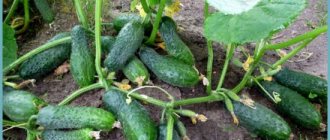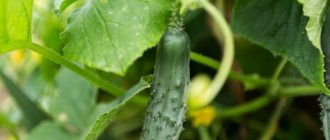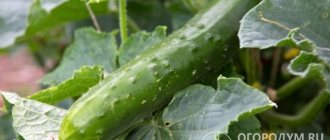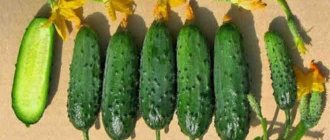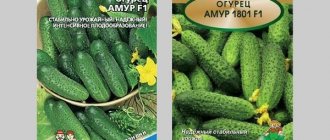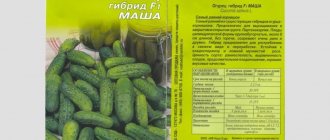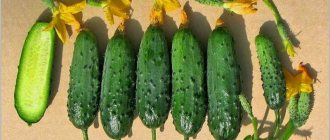Characteristics of Dirigent cucumbers
It is better to start describing the Dirigent cucumber variety by showing a photo.
This is an early ripening, hybrid variety that does not require pollination. It can be grown in open and closed ground. For good fruiting, regular and abundant watering is important.
The plant has strong, strong shoots that form and constantly regenerate on the main stem. The lateral processes are weak, often die, and do not develop completely.
After sowing, the seeds germinate quickly and amicably. Fruit ripening occurs 40 days after seedlings are planted in the ground.
Important! The vines of Dirigent cucumbers are short, so the plant does not need to be tied up.
The leaves are small, serrated, sparse. Thanks to their small leaf size and small quantity, cucumbers are quite easy to harvest.
The fruits of the Dirigentne variety are large, up to 15 cm in length and up to 80 g in weight. Their size remains virtually unchanged throughout the entire ripening stage. 2-3 cucumbers are formed in one fruit node. The skin of the fruit is dark green, thin, lumpy. There are short yellow stripes on the surface.
Pros and cons of the variety
The negative qualities of the variety include the high cost of seed material; it cannot be collected independently at home.
Among the positive properties are:
- variety resistance to powdery mildew, brown spot, cucumber mosaic virus;
- high productivity;
- rapid fruit ripening;
- drought resistance;
Important! The fruiting of the variety is constant and uniform throughout the entire period of ovary formation.
Optimal growing conditions
Cucumbers of the Dirigent variety are grown from seeds or seedlings. To get an early harvest in a greenhouse or open ground, use the seedling method of growing under film. Seedlings are planted in greenhouses in May. Plants are rooted at the rate of 3 seedlings per 1 m2. When planting in open ground, use a scheme of 5 plants per 1 m2.
The optimal soil temperature for rooting in open ground should be + 18 ᵒC. Watering is carried out at least 2-3 times a week.
To obtain high yields, cucumbers are fed with organic or mineral fertilizers up to 5 times per season. Once every 7 days, remove weeds, water the plant at the roots, and mulch the soil. When pests appear, spray with chemicals or use folk remedies.
We grow a hybrid ourselves
The crop is interesting because it can be grown in two ways: seedlings and direct planting in the ground.
Sowing seeds in the ground
Seeds are sown in the beds when the soil warms up to +18...19 °C. Before sowing, pre-made holes are fertilized with peat or humus. If the beds are mulched, this will attract worms, which will loosen the soil. This improves its breathability, and oxygen is necessary for the full development of plants. In addition, mulch helps the beds stay moist longer.
Seeds are sown to a depth of 1 cm, with their nose up . This method of planting will speed up the process of seed germination. After sowing, the bed is covered with non-woven material and sprayed over the cover with warm water from a spray bottle. When shoots appear, the covering material is removed.
Planting seeds for seedlings
Sowing seeds for seedlings begins 20-25 days before transplanting to a permanent place. It is impossible to collect seed material yourself, since hybrid crops do not retain their parental properties in subsequent generations. That's why they are bought every season. The manufacturer processes the seed material himself, so it does not require additional preparation for planting.
Only individual containers are suitable for sowing . The root system of cucumbers is vulnerable and difficult to tolerate picking and replanting to a permanent location. Therefore, they choose peat pots or sow them in eggshells. When planting seeds in these containers, subsequent replanting into the ground is not required, since both peat and eggshells dissolve in the ground on their own without harm to the roots.
The soil is prepared from garden soil mixed with peat. The finished mixture is poured with a hot solution of dark potassium permanganate or steamed in the oven for 15 minutes at a temperature of +50 °C.
The seeds are sown to a depth of 1 cm. After sowing, the soil is slightly compacted and moistened with warm, settled water from a sprayer. Then they are covered with film to simulate greenhouse conditions and left in a bright room at a temperature of +22 °C.
When shoots appear, the film is removed. Water as the top layer of soil dries out from a shallow watering can. After watering, the soil is carefully loosened.
Reference. Cucumbers are moisture-loving plants, but you shouldn’t overwater them. Excess moisture threatens rotting.
Two weeks after germination, the first fertilizing with mineral fertilizers is carried out.
The seedlings are ready to be transplanted into the ground as soon as at least three true leaves are formed.
Growing cucumbers Dirigent F1
The variety is recommended for cultivation in the central and southern regions of Russia. In this area, cucumbers can be planted directly in open ground in May. In the northern regions of the country, the variety can also be grown, but in a greenhouse or heated greenhouse. Farmers send reviews with photos and descriptions of Dirigent cucumber fruits from almost every region of Russia. This only confirms the fact that the variety can be grown in any climatic conditions.
Direct planting in open ground
In the south of Russia, seedlings or seeds of Dirigent cucumbers are planted in late April or early May in open ground. At this time there are no longer night frosts.
The area for planting is dug up and organic fertilizers are added: manure, peat, humus. You can also use potassium-phosphorus fertilizer. For seeds, long, narrow grooves are cut into which the seeds are placed with the sharp end up. They are deepened no more than 10 mm. Then they are covered with soil and watered. At the last stage of planting, the soil is mulched. This will conserve moisture and slow down weed growth.
Important! If there is a possibility of night frosts, the seedlings are covered with film in the evening and removed in the morning.
Growing by seedlings
Cucumber seedlings can be purchased or grown at home. To do this, the seeds are planted in special containers. They are filled with soil from the garden plot or purchased special planting soil. Furrows are cut in it and seeds are placed there, then they are covered with a thin layer of earth and watered. The containers are covered with film and placed in a warm, well-lit place. After 3 days, the covering material can be removed.
As soon as 2-3 true leaves appear on the seedlings, the grown plants can be planted in the ground. Dirigent cucumbers take root well and grow in any type of soil.
Seedlings are planted in holes filled one third with humus or peat. The distance between each plant should be at least 30 cm. Before planting, the soil is also carefully dug up and fertilized. After the seedling has rooted, the hole is filled with loosened soil, watered abundantly, and mulched.
Watering and fertilizing
In arid regions, cucumbers are watered daily. Do this in the evening so as not to burn the leaves under the scorching sun. In other cases, the crop can be watered every other day. Water is poured at the root - moisture should not get on the leaves.
The first fertilizing is carried out 2 weeks after planting the seedlings in the soil. Then you need to apply fertilizer 2 more times until flower stalks form. During the formation of ovaries, cucumbers are fed 2-3 more times. Fertilize the crop with organic or mineral fertilizers created for feeding cucumbers.
Formation
The formation of cucumber crops is carried out to increase its productivity. This stimulates the formation of ovaries, rather than the growth of side shoots.
The formation of Dirigent cucumbers is done as follows:
- After planting the seedlings, they are given time to take root (about a week).
- Afterwards the bushes are tied to the trellis.
- As soon as the top of the seedling grows to the level of the wire, the plant is pinched and no more than 3 leaves are left on the stem.
- The stem is then wrapped around a stretched rope. The side shoots of the Dirigent variety are not pinched, as they are underdeveloped.
Important! Dirigent cucumbers can be grown spread out without tying them up. To do this, cover the soil with a thick layer of peat, sawdust or hay.
Protection from diseases and pests
The Dirigent variety is resistant to pests and diseases, especially fungal ones. If there are aphids or mites on the seedlings, it is necessary to treat the plants with insecticides.
Among the types of plant protection from insects that are safe for humans, the following are used:
- soap solution;
- infusion of onion peel;
- garlic infusion;
Any of the proposed products is sprayed on the stems and leaves of the plant.
Cucumber Dirigent: description, planting and care, reviews, photos
The early period of fruiting and the universal use of the crop among cucumber varieties are highly valued. The German company Rijk Zwaan Welver GmbН, specializing in the sale of seed material, offered vegetable growers a new hybrid - Dirigent, which meets these qualities.
An application for registration of the new product was submitted in 2006; the cucumber was included in the State Register of Breeding Achievements of Russia in 2011. After variety testing, the variety was zoned in the Central region, including Bryansk, Vladimir, Kaluga, Ivanovo, Ryazan, Moscow, Smolensk and Tula regions.
It is recommended for cultivation in open ground, but in cool regions this crop is also successfully grown in greenhouses. This is a hybrid, so the seeds are always labeled F1.
Description
The plant is indeterminate, of medium vigor, medium branched, moderately leafy. It is characterized by constant shoot regeneration. The internodes of the variety are short. The leaves are small to medium in size, green or dark green in color, slightly wrinkled on the surface, and have a long petiole. Female flowering type. There are from 1 to 3 female flowers in one leaf node.
The fruits of Dirigent are short, cylindrical, up to 10 cm long (maximum length 14 cm). The ratio of length to diameter is 3.1:1. The skin is thin but dense, green in color, with short light stripes and moderate spotting. The shirt type is German. The surface of the cucumber is covered with frequent and very small tubercles, the pubescence is white and dense.
The pulp is dense, without voids, tender, juicy, without bitterness, white-green in color. The taste is sweet - good and excellent. Gardeners also speak highly of the taste of the crop. The seed chamber is small, small seeds are in the stage of milky ripeness. The size of the fruit does not change throughout the entire harvesting period.
The weight of greens, according to the State Register, is 67 - 80 grams.
Characteristics of the variety
- In terms of ripening time, Dirigent is classified as mid-early. From the moment of emergence of seedlings to the beginning of fruiting, 40 - 42 days pass;
- Fruiting is constant and uniform throughout the entire period, without jerks. Marketable yield is 476 - 692 c/ha, which is 127 - 171 c/ha higher than that of Druzhina F1 and Semcross F1 taken as the standard;
- The reliability of the variety is confirmed by good immunity. The State Register notes the high resistance of cucumber to olive spot and cucumber mosaic virus;
- our hero belongs to the parthenocarpic family, so he easily produces crops on his own both indoors and outdoors, even under unfavorable weather conditions;
- Dirigent is considered very plastic, adapts perfectly to environmental conditions (but only in the tolerance region);
- the fruits of this variety do not outgrow and perfectly retain their original shape;
- transport qualities are very good. Keeping quality, subject to storage standards, does not fail;
- The way to eat cucumbers is universal. Zelentsy are good in salads and have excellent pickling qualities, because the finely tuberculated fruits are considered the standard for lightly salted cucumbers and are suitable for pickling and canning.
Agricultural technology
The Dirigent hybrid can be grown by seed or seedlings. The latter is considered the most reliable and convenient, as it allows you to save seeds and get an earlier harvest (when grown under covering material). To cultivate the variety in an open bed, seeds are sown for seedlings in early May and transplanted to a permanent place in early June.
For the greenhouse, seedlings begin to grow earlier - at the end of April. In this case, transplantation into closed ground is carried out in May. The optimal planting density of cucumbers in a greenhouse is 2.5 - 3 plants per 1 square meter; outdoors you can plant them denser - up to 5 plants per 1 square meter. meter. The plant prefers light, fertile humus soils with a pH of 6.3 - 6.8.
When preparing the site, in the fall it is recommended to apply manure from 5 to 10 kg per 1 square meter for digging. After rooting the seedlings, the bushes are tied to a trellis. According to some sources, our hero can also be grown spread out, which makes caring for him much easier. In this case, you need to lay mulch under the stems.
Otherwise, care is usual for the culture as a whole.
Hybrid Dirigent has proven itself to be reliable and productive, which is why it has earned high marks from vegetable growers. The open type of bush makes it easier not only to care for, but also to harvest. When growing cucumbers under non-woven material, the crop ripens earlier than expected. No significant deficiencies were identified in the variety. But seeds will have to be purchased annually.
Growing cucumber Dirigent
Among the many species, the Dirigent cucumber is one of the most common crops. It was bred in the Netherlands by crossing 3 varieties. From each of them, Dirigent f1 received only the best characteristics, thanks to which it is highly valued by gardeners.
Growing cucumber Dirigent
Bushes
According to the description, cucumbers of the Dirigent variety are medium-sized. The side shoots are weak, which is why they die at the beginning of development. The most important shoots always appear only on the main stem.
The leaves on the bushes are small and dark green. They are smooth in structure. The bushes are distinguished by female flowering; there are always no more than 3 female flowers in a node.
Fruit
The average length of one fruit is 11 cm. They are not too large in size, weighing about 90 g. Cucumbers have a delicate and thin skin with small tubercles.
The description of the fruit pulp is as follows: it is always crispy and has a pleasant aroma. Vegetables have high taste qualities. They have no bitterness, so they are a great addition to any salad.
Planting methods and rules
There are 2 ways of planting cucumbers: seedlings and non-seedlings. Each of them has its own characteristics. The first method is a little more complicated, so it is recommended for more experienced gardeners.
Description, advantages and disadvantages of the cucumber hybrid “Dirigent f1”
Dirigent F1 is a young variety of cucumbers, obtained by scientists not very long ago. Homeland - the Netherlands. Bred by Dutch breeders. To create this, the best qualities of three types of cucumbers were combined.
It has taken root in Russia so much that already in 2011 it was included in the state register of selection achievements. The market conquered in 2006.
This is a first-generation hybrid and cannot be used to produce seeds for subsequent plantings.
Plant characteristics
And its early ripeness is appreciated by our compatriots. Currently, gardeners and farmers are planting in most regions of the Russian Federation, in particular the Moscow, Tula, Bryansk and Ryazan regions. Often grown in Ukraine and Moldova.
The height of the bush is medium in size and ranges from 80 to 160 cm. The bushes are medium-branched and have a small number of small leaves. Medium-sized leaves are less common. The leaves are smooth with a long petiole and have a rich green or dark green tint.
They tolerate heat well and do not wither at high temperatures. Flowering is of the female type, most often the nodes are located at the ovary. Internodes are medium sized. It takes root well in the soil. The stem is the center of the main shoots. Growth rate is average.
- Short, small in size 8-10 cm.
- The maximum length of the greens is up to 14-15 cm.
- Weight 70-80 g.
- The shape is neat, cylindrical.
- Average diameter 3.1 cm.
- The color of the cucumber is green or dark green, with light stripes.
- Has spots of medium and weak severity.
- The peel is dense, moderately lumpy. The tubercles have strong white pubescence.
The pulp is soft, elastic, and has small seeds. The color is light with a greenish tint. When bitten, a characteristic crunch is heard. The taste is grown, with a sweet aftertaste, the flesh is juicy. Suitable for use fresh or canned. When canning, the size of the vegetable often matters, which makes the variety suitable for pickling.
Variety yield, pollination and diseases
For every m2 it is possible to collect about 7-10 kg of crop. In greenhouse conditions you can get from 16 to 25 kg per season. It is important that the amount of vegetables depends entirely on the conditions of care - in unfavorable conditions, the yield will be reduced. On an industrial scale, there are 500-600 centners of vegetables per 1 hectare. The variety is parthenocarpic, so it does not require pollination.
During the crossing process, the main diseases of the crop were taken into account and resistance to certain diseases was developed:
- Powdery mildew. A fungal disease resulting from the spread of fungal spores. It begins with a white coating on the leaves and stems, gradually affecting the plant.
- Cucumber mosaic. A viral disease that begins with white spots that destroy the plant. It can significantly reduce the share of the harvest or deprive it altogether.
- Brown spot. A fungal disease, expressed in the absorption of plant vitality by brown spots.
But, having immunity, the plant can suffer from pests. For example, spider mites or aphids, whiteflies. In this case, the plant is treated with special solutions.
Source: https://agro-feed.ru/sad-i-ogorod/ogurets-dirigent-opisanie-posadka-i-uhod-otzyvy-foto
